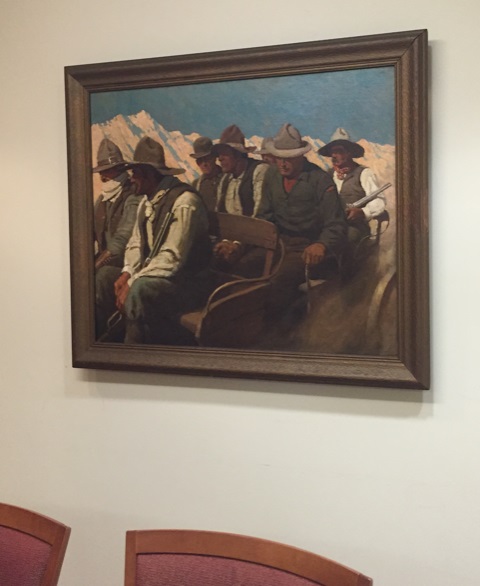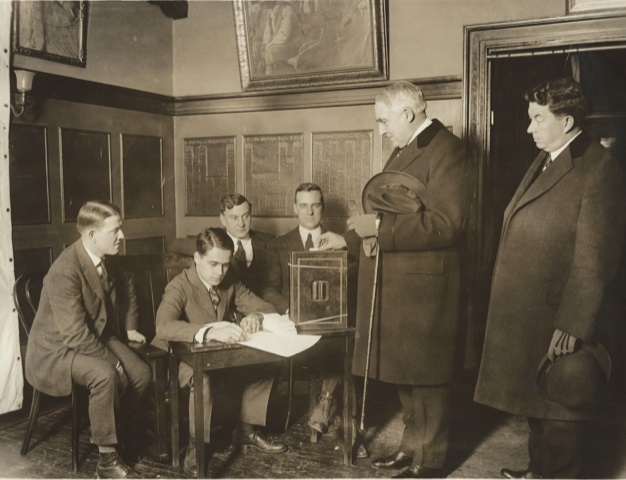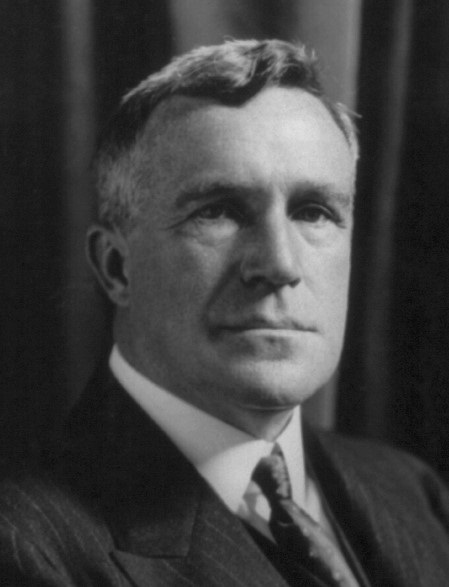A painting of an Old West scene with seven rough men – three of them handcuffed -- riding in a buckboard hangs in the National Press Club’s library conference room. It is a work by renowned early 20th century illustrator N.C. Wyeth, whose original paintings are highly sought-after by collectors.
Wyeth is famous for his illustrations that appeared in books, magazines and posters. He is also the father of Andrew Wyeth, one of the great artists of the mid-20th century.
But for a long time, no one had a clue as to how and when the Club acquired this painting.

A chance discovery on eBay set the Club’s History and Heritage team off on a hunt for the answer.
Warren Harding was a newspaperman, the publisher of the Marion (Ohio) Star before he went into politics. He joined the Club in 1915 when he arrived to take his seat as an Ohio senator, and he stopped by often, sometimes to play poker, even after he became U.S. president in 1921.
That meant he qualified as an active (journalist) member of the Club, able to vote in its elections. One of the Club’s most famous photographs shows the president dropping his ballot into the box.
While I perused eBay, a similar photo popped up. While this photo was taken at the exact same second as the photo we have in the archives, the photographer for this photograph was in a slightly different position — just to the right of the other photographer — and he caught the lower portion of a painting over Harding’s head.
And there it is: Our Wyeth.

That means the painting has been in the Club for a century. But it still didn’t answer the question of exactly when and how we got it.
The photo was taken when the Club occupied its third quarters (1914-1927) atop the Albee/Riggs building at 15th and G Streets NW. The Club’s 1914 Yearbook noted that the Club paid $15,000 to furnish the new digs. Was the painting purchased with that?
Club archivist Jeff Schlosberg scoured the records and said he could find no trace that the board purchased this painting – or any painting -- that adorned the walls.
The team’s art history writer, Menachem Wecker, sleuthed the painting and found it listed among Wyeth’s works compiled by the Brandywine River Museum of Art in Chadds Ford, Pa.
He came up with this information.
Our painting is one of four that Wyeth produced for a Saturday Evening Post story, “Number 9009,” that ran on Aug. 1, 1908, the same year the Club was founded. The caption under the illustration read: “His right wrist linked to a garroter.” (A garroter is someone who kills by strangling).
Since all things can be found on the internet, I purchased a copy of the Aug. 1, 1908, Saturday Evening Post.
The three men in the middle seats are convicted felons, being taken to prison by the sheriff in the front and his deputies. One was a murderer, one was a garroter, and the third was charged with burglary and assault to commit murder.
The third man is the one in the middle, and he is the protagonist in the story. After he reaches prison, he is given a uniform with the number 9009 stenciled on the back. The story, the first of four parts, describes the violent world in the prison as 9009 tries to learn what he must do to earn “good time” that would lead to an early release.
Apparently, this was not one of Wyeth’s favorite paintings. The website quotes him writing at the time, “I am at work on the last Post drawings for the convict story and feel greatly relieved therefrom. I have done some very poor work on that story, and simply because I was not in sympathy with it.”
But if the Club didn’t buy it, how did we get it?
Team member Ed Grosvenor, editor of American Heritage Magazine and third generation of the Grosvenor family that ran the National Geographic Magazine, had this insight.
“N.C. Wyeth was generous and well known for giving his paintings away, often to publishers he worked with,” Grosvenor said.
Or perhaps, he said, the painting could have been donated by George H. Lorimer, the editor of the Saturday Evening Post from 1899 to 1936.



